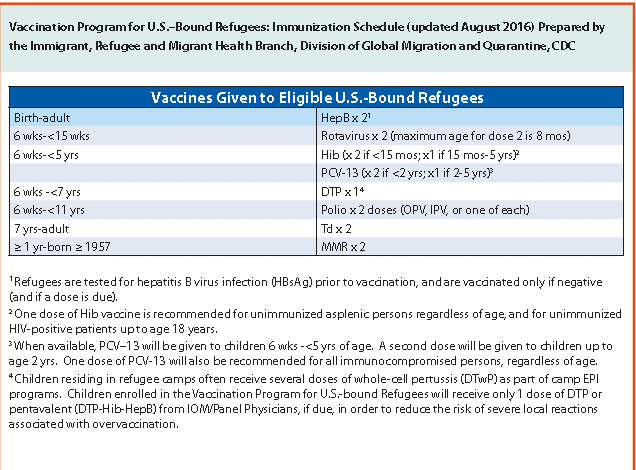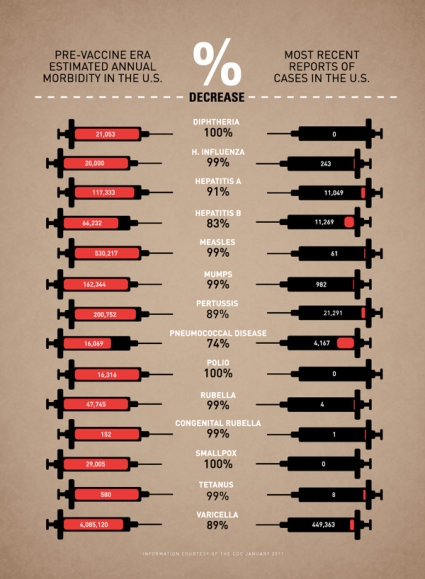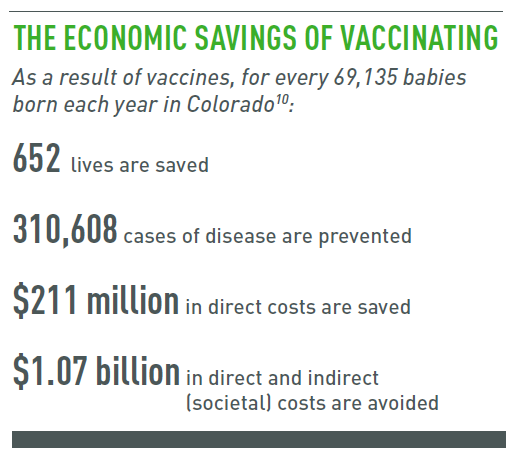Vaccines aren’t just for children; adults also need certain vaccines to help protect them from preventable disease over the lifespan. During the adult immunization week of National Immunization Awareness Month (NIAM), Rosemary Spence, RN, MA, shares insight into how providers can ensure their adult patients are adequately immunized.
Why Vaccination Is One of the Best Choices You Can Make As a Parent
Content adapted from the Centers for Disease Control and Prevention (CDC)
As parents, we want to do what is best for our kids. We want to keep our little ones safe and healthy so that they can grow, learn, and be kids. We know about the importance of car seats, baby gates, and other ways to keep babies and young children safe. But did you know that one of the best ways to protect your children is to make sure they receive all of their vaccinations? During National Immunization Awareness Month, we share a few reasons why vaccination is one of the best and most important things you can do to protect your child.
Back-to-School Season is Here! Tri-County Health Department Offers Back-to-School Immunization Clinics
Guest post by Tri-County Health Department
When you think of back-to-school season, you might think about new books, backpacks and binders, but you may not think of vaccines! Colorado law requires students at licensed child care centers and schools to be vaccinated against certain diseases. Many people know that vaccines are recommended for babies, but additional doses are required for kindergarten and sixth grade entry to keep kids healthy and protected from preventable illness throughout the school year. Many colleges also require certain vaccines after age sixteen. More information on which vaccines are required in Colorado can be found here.
Connecting New and Expecting Parents With Health and Safety Resources: The 2018 Community Baby Fair
New parenthood is incredibly exciting, scary, wonderful, and challenging—all at once! With so much information and so many opinions from different sources, it’s hard to know just how to best keep a new baby safe. From car seat installation to finding a pediatrician to safe sleep, having evidence-based expert information is key. And parents shouldn’t have to navigate their parenthood journey alone. Enter: The Annual Community Baby Fair, hosted by the Colorado Children’s Immunization Coalition (CCIC)!
[Read more…]Refugee Immunizations: Background and Current Overseas and Domestic Approaches
Guest post by Janine Young, MD, FAAP
Associate Professor of Pediatrics, University of Colorado School of Medicine
Medical Director, Denver Health Refugee Clinic
Globally, we are witnessing the worst humanitarian crisis since World War II; there are over 65 million displaced people and, of these, less than one percent are referred by the United Nations High Commissioner for Refugees (UNHCR) for permanent resettlement to other countries. The maximum number of U.S. refugee arrival numbers is decided by an annual Presidential determination. In federal fiscal year 2016, the U.S. resettled 85,000 refugees; however, for this fiscal year, 2018, the arrival number was lowered to 45,000. In fiscal year 2017, the US resettled 51,392 refugees. This compares to Germany’s initiative in 2015 to resettle over 900,000 refugees, over half from Syria.
After a refugee is referred to the U.S. resettlement program from UNCHR, refugee applications are vetted by numerous federal agencies and include multiple background checks and finger-printing. The average length of time for an application to be approved for resettlement to the U.S. is 18-24 months but can vary by an applicant’s country of origin. Refugee status is a legal one, allowing for permanent resettlement to the U.S. Defined by international convention, refugees are individuals who, owing to a well-founded fear of being persecuted for reasons of race, religion, nationality, or membership of a particular social group or political opinion, are outside their country of nationality and are unable or unwilling to return to their home country.
Once refugees have been approved for resettlement to the U.S., they begin multiple medical evaluations. The medical evaluations are conducted by panel physicians appointed by the U.S. consulate or embassy or, in the case of large refugee movements, by the International Organization for Migration (IOM). These evaluations (which are performed in accordance with technical requirements and instructions from the Centers for Disease Control and Prevention’s Division of Global Migration and Quarantine) include initiation of immunizations. In most cases, first doses are given 3-6 months prior to departure, with the goal of providing at least 2 doses of each vaccine, depending on availability and logistics at each overseas refugee screening site (see table below). Live viral vaccines (e.g. MMR, varicella, rotavirus) are routinely not given less than 4 weeks prior to travel (except in certain outbreak settings) given the potential impact of live viral vaccines on other immunization initiation and testing interpretation upon arrival to the U.S.

At U.S. arrival, refugees are linked to a Domestic Medical Examination (screening) to test for clinical conditions that may be suggestive of underlying disorders. In Colorado, there are four sites that perform screening—Denver Health and Hospitals/Lowry, Metro Community Provider Network/Elmira, Sunrise Community Health/Montford, and Peak Vista Community Health Centers/Myron Stratton—all Federally Qualified Health Centers. Screening occurs within 90 days of arrival to the U.S., although the goal is to perform them within 30 days. At screening, administration of additional vaccines and/or testing for immunity occur.
Refugees are given standard information about the need to complete vaccination series during screening visits; however, completion of vaccination series often occurs in concert with efforts by Local Public Health Departments, School-Based Health Centers, school nurses and other primary care clinics.
There is much coordination that occurs at screening sites for new refugee arrivals. This involves efforts to assure that proof of historical vaccination is uploaded and that proof of immunity to vaccine preventable diseases is manually entered into the state database, Colorado Immunization Information System (CIIS). This ensures that refugees’ immunization history is easily accessible and reliable. Other efforts include assuring that catch-up vaccinations are administered at appropriate intervals, which is currently not calculated correctly for catch-up doses of IPV, Td and Tdap in many electronic medical record systems.
To learn more about refugee immunizations in Colorado, please visit the Colorado Refugee Immunization Provider Resource Hub. This website was developed by the members of the Colorado Refugee Immunization Taskforce as a centralized compilation of refugee immunization-related information, resources and guidelines to benefit providers who administer immunizations to refugees within the Colorado community.
For more information about catch-up vaccine schedules and correct intervals, please consult:
CDC Adult Immunization Schedule
CDC Child and Adolescent Schedule
CDC Immunization Phone App
Vaccination Program for U.S.-Bound Refugees, CDC
Guidelines for the U.S. Domestic Medical Examination for Newly Arriving Refugees, CDC
Two Shots to Beat Cancer: How One Teen is Fighting Back Against HPV-Related Cancers
Guest post by Allyson Rosenblum
In honor of National Cancer Prevention Month, Allyson Rosenblum shares how she’s rallying teens across the U.S. to prevent cancers caused by the human papillomavirus (HPV). [Read more…]
4 Reasons to Be Thankful for Vaccines This Thanksgiving
While we appreciate our loved ones all year round, Thanksgiving provides a special occasion to reflect on who and what we’re most thankful for. This and every year, vaccines provide something to be thankful for—and here’s why:
1. Because vaccines allow us to protect our loved ones through prevention.
We do everything in our power to protect the little ones in our lives—from researching the safest car seats, to choosing healthy foods, to kissing boo-boos both emotional and physical. Our primary goal is to keep children safe, healthy and happy. We don’t expect the worst to happen. But we buy and use the car seat, we arm kiddos with helmets, and we learn the Heimlich and CPR. Just in case. We prevent what we can because we never know what might happen. And by getting kids vaccinated, we’re doing just that. By keeping up to date with the Centers for Disease Control and Prevention (CDC) recommended immunization schedule, we’re giving our children the best shot at preventing disease. Even if we can’t possibly imagine that they’ll contract an illness, we prepare for the worst by preventing what we can in the best way we can.
2. Because vaccines protect our communities’ most vulnerable individuals through Community Immunity.
Mom, dad, friend, neighbor, colleague, schoolmate—even the grocery store checker. These are the faces of our communities. When we choose to vaccinate, we protect not only ourselves and our children, but everyone around us. Some individuals in our community can’t get vaccinated against certain diseases, and are therefore more vulnerable to these diseases and their complications.
Pregnant women, babies and young children, the immunocompromised and the elderly—even those with certain allergies—rely on everyone else in their community who can get vaccinated to do so. When enough people are protected from a disease, it’s hard for that disease to spread throughout a community and reach these vulnerable populations. One of your community members—your neighbor, your friend’s son, your bank teller, your mail carrier—might not be able to be vaccinated. It’s up to all of us to protect each other. We can give thanks for our communities by getting vaccinated and making sure everyone is protected. We can support our herd and our community.
3. Because vaccines have helped eliminate deadly disease worldwide.
We live in an amazing time in history. For the first time, we have the ability to prevent once-deadly diseases that ravaged—even wiped out—communities worldwide. That’s why vaccines are considered one of the greatest public health achievements of the 20th century. For instance, the last case of smallpox, a disease that killed approximately 300 million people worldwide during the 20th century, was last seen in 1979—making it the first disease to be fully eliminated through global vaccination and other public health efforts.
And polio? Most of us have never seen a case of polio. But in the 1940s and 1950s, polio outbreaks were extremely common and affected more than 35,000 people—just in the U.S.—each year. Because the disease is highly infectious and can lead to paralysis, parents across the country were scared to let their children out of the house for fear that they might catch the potentially deadly disease. In the U.S., the fear of polio all but disappeared when the disease did. There hasn’t been a case of polio in the U.S. since 1979, so we don’t see first-hand how devastating the disease can be. Thanks to the polio vaccine and to massive global vaccination campaigns, the U.S. is polio-free and we are tantalizingly close to eliminating polio worldwide. Polio is only a plane ride away, and vaccination ensures that our children and future generations can prevent polio from returning. Last year, there were only 37 cases worldwide in just 3 countries. Thanks to coordinated global vaccination efforts, polio cases have decreased by over 99 percent.
This infographic shows just how substantial the impact of vaccines has been for other diseases:
Credit: Leon Farrant
4. Because vaccines save lives—and money.
Vaccines are credited with preventing 2 to 3 million deaths worldwide each year—and that’s just from diphtheria, tetanus, whooping cough (pertussis), and measles. According to the World Health Organization, though measles is still responsible for taking the lives of over 100,000 children globally each year, the measles vaccine has saved 17.1 million lives since the year 2000.
Vaccine-preventable diseases and their complications pose a cost not only to human life, but also to economic resources. The individual and societal cost of a single case of measles (including doctors’ visits, hospitalization, time taken off work, and public health interventions) is a whopping $83,000. But the cost of vaccination, though initially high, is far less than the cost of treatment and prevention. For instance, the eradication campaign for smallpox cost US $100 million. But since smallpox was eradicated we’ve saved US $1.3 billion in smallpox treatment and prevention costs each year.
Even though the economic cost of vaccination outweighs the benefit economically-speaking, the benefit of saving a person—a child—the pain that comes with contracting a vaccine-preventable disease is invaluable.
Source: The State of the State’s Immunizations Report
Thanksgiving is all about spending quality time with our friends and family—the people who mean the most to us. These people are our priority, and vaccines can help to protect them from contracting nasty (and potentially life-threatening) illnesses. Vaccines help to protect our global community–others’ loved ones—too. We give thanks for any opportunity we have to prevent harm to those we hold dear, and vaccination is at the top of that list.
For more information about vaccines, visit www.immunizeforgood.com.
Do You Know Your Child’s School’s Vaccination Rates? We Sure Do.
Guest post by Elizabeth Brown
When my son started public school, he had recently been diagnosed with adrenal insufficiency. His body could not produce cortisol, which negatively affects different systems in the body—especially the immune system. What is an innocuous cold for an otherwise healthy person could easily become life threatening for him. [Read more…]
What Can Healthcare Providers Do to Help Improve Teen Vaccination Rates in Colorado?
The Centers for Disease Control and Prevention (CDC) recently released its annual report on adolescent vaccination coverage.
While it’s encouraging to see slight improvement in vaccination rates, too many Colorado teens remain under-vaccinated against serious infectious diseases. Rates are particularly low for the human papillomavirus (HPV) vaccination series in Colorado – only 52.1 percent of girls and 44 percent of boys completed the HPV series. Nationally, just 39.1 percent of teens have received the recommended second dose of quadrivalent meningococcal conjugate vaccine (MenACWY), which means they might not be protected against meningococcal meningitis. Additionally, in 2015, less than half of teens 13 through 17 years of age received the influenza vaccine.
[Read more…]
Heading Back to School? Make Sure Your Teen is Up to Date on Immunizations to Stay Healthy
Guest post by Jefferson County Public Health
In honor of National Immunization Awareness Month, Jefferson County Public Health (JCPH) encourages parents to ensure their child is up to date on all recommended immunizations, including the HPV (human papillomavirus) vaccine, before heading back to school.
They’ll always be your baby, even when your little boy towers over your head or your baby girl is going through her first heartbreak. Though the diapers and baby teeth have been replaced by hormones and acne, your teen still needs your help to be healthy. [Read more…]
- « Previous Page
- 1
- …
- 6
- 7
- 8
- 9
- 10
- …
- 16
- Next Page »


